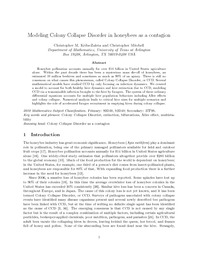| dc.contributor.author | Kribs, Christopher David | |
| dc.contributor.author | Mitchell, Christopher | |
| dc.date.accessioned | 2016-07-12T13:35:10Z | |
| dc.date.available | 2016-07-12T13:35:10Z | |
| dc.date.issued | 2014-12 | |
| dc.identifier.citation | Published in Mathematical Biosciences and Engineering 11(6):1275-1294 | en_US |
| dc.identifier.issn | 1547-1063 | |
| dc.identifier.uri | http://hdl.handle.net/10106/25814 | |
| dc.description | Author's final draft, also known as a pre-print. | en_US |
| dc.description.abstract | Honeybee pollination accounts annually for over $14 billion in United States agriculture
alone. Within the past decade there has been a mysterious mass die-off of honeybees, an
estimated 10 million beehives and sometimes as much as 90% of an apiary. There is still no
consensus on what causes this phenomenon, called Colony Collapse Disorder, or CCD. Several
mathematical models have studied CCD by only focusing on infection dynamics. We created
a model to account for both healthy hive dynamics and hive extinction due to CCD, modeling
CCD via a transmissible infection brought to the hive by foragers. The system of three ordinary
differential equations accounts for multiple hive population behaviors including Allee effects
and colony collapse. Numerical analysis leads to critical hive sizes for multiple scenarios and
highlights the role of accelerated forager recruitment in emptying hives during colony collapse. | en_US |
| dc.description.sponsorship | This article grew out of a project supported by NSF UBM-Institutional grant DUE-0827136 as
part of the UTTER Program at UT Arlington (http://www.uta.edu/math/utter). The authors
of this manuscript acknowledge and thank their co-authors on the original project. | en_US |
| dc.language.iso | en_US | en_US |
| dc.publisher | American Institute of Mathematical Sciences | en_US |
| dc.subject | Colony collapse disorder | en_US |
| dc.subject | Extinction | en_US |
| dc.subject | Bifurcation | en_US |
| dc.subject | Allee effect | en_US |
| dc.subject | Multistability | en_US |
| dc.title | Modeling colony collapse disorder in honeybees as a contagion | en_US |
| dc.type | Article | en_US |
| dc.publisher.department | Department of Mathematics, University of Texas at Arlington | |
| dc.identifier.externalLinkDescription | The original publication is available at Article DOI. | |
| dc.rights.license | Licensed under Creative Commons, CC BY | |
| dc.identifier.doi | doi:10.3934/mbe.2014.11.1275 | |

